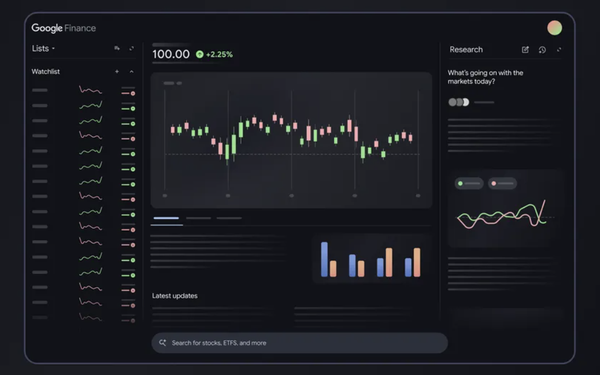
Ignoring AI’s potential risks can turn it into a liability
-- even for Google, which began piloting a Finance page that allows users to ask detailed questions about the financial
sector and receive comprehensive answers generated by AI based on real-time data from across the web.
It’s not clear how Google purges the bias and unreliable answers, but the Finance
pages return complete answers from advanced charting tools and allow users to visualize financial data beyond simple asset performance.
Technical indicators enable users to plot moving
averages or adjust displays to see candlestick and other types of charts that are based on real-time news and data. Users can see these charts, as well as data on commodities and cryptocurrencies.
Google surely used some of the same advertising philosophies when creating AI-based financial graphs and pages.
advertisement
advertisement
Similarities between individual stock investors and advertisers in terms of
data include using historic metrics, tracking trends, defining objectives and KPIs.
Where stock investors begin by setting clear financial goals such as capital appreciation, dividend income,
or risk management, advertisers establish campaign objectives such as increasing brand awareness, driving sales, or improving website traffic.
Investors track metrics such as stock price,
trading volume, price-to-earnings (P/E) ratio, and dividend yield, whereas advertisers monitor click-through rate (CTR), conversion rate, cost per click (CPC), and return on ad spend (ROAS).
Reveal, a developer of white-label real time analytics platforms, ran its sixth annual survey from December 2024 to January 2025. About 250 technology leaders participated. Part two, which was
published in June, showed that tech leaders -- the same type who plot software expenditures for brands and agencies -- plan to expand their use of AI, with 73% identifying it as their primary focus
— because they are driven largely by automation and productivity gains.
Even with the expansion of AI, the real concerns center on AI risks such as data privacy, security, and model bias
and how individuals or companies determine performance in any type of AI-based model around these types of risks.
Data privacy emerged in Reveal’s study as the most pressing concern,
with 78% of respondents citing it as their top issue. Transparency at 57% and data safety at 55% closely followed, reflecting widespread unease about how AI systems are developed and deployed.
Companies are taking action, and more than 60% have implemented ethical AI guidelines, while 59% have implemented formal privacy policies to protect against misuse, and 54% have introduced
protections for sensitive information.
Fifty-five percent of participants in the survey said the main driver of AI adoption is task automation to boost productivity. Other notable ways that
companies are using AI in software creation include optimizing code at 48%, improving diagnostics at 46% testing software at 46%, fixing coding errors at 43%, eliminating repetitive or administrative
tasks at 43%, creating personalized experiences for customers at 41%, reducing development time and improving productivity, and addressing limited resources at 28%.
Ethical considerations have
centered on navigating AI bias, privacy violations, and untested technology. As AI becomes more deeply embedded in software development, the ethical stakes continue to rise.
The survey suggests from participants’ responses that privacy
violations at 38%, bias in AI models at 37%, and the deployment of AI applications that have not been securely tested at 36%. These are among the most concerning issues for organizations this
year.
These risks not only threaten user trust but also expose companies to legal and reputational fallout. As AI and software development continue to converge, organizations must mitigate
risk. The message focuses on strong ethical principles, rigorous testing, and comprehensive governance frameworks.
While objectives and domains differ, individual stock investors and
advertisers create ad campaigns that leverage data analysis techniques, from defining objectives and KPIs to optimizing strategies based on performance data.
Investors primarily analyze
financial and economic data, while advertisers focus on consumer behavior and marketing metrics. The ability to effectively interpret and act on data is essential for both.